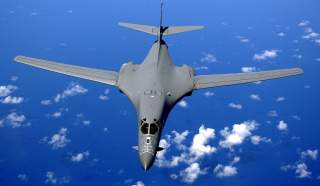Want to Open the Ultimate Pandora's Box? Bomb North Korea
There is a reason Washington never attacks the DPRK when it causes trouble.
U.S. Secretary of State Rex Tillerson made waves last week when he suggested that military action against North Korea was an option. He pointedly said that former President Barack Obama’s ‘strategic patience’ approach was over. Tillerson did not say what military options were under consideration, but bombing is the likely choice. The United States has air superiority over North Korea by a wide margin, while it is unclear what kind of naval action would be available, and ground action of course has huge risks.
The idea of retaliating against North Korea has, of course, been around for a long time. North Korea provokes South Korea, Japan, and the United States regularly. Several of those provocations were severe enough that military action would likely have enjoyed some global acceptance. In 1968, the North Koreans captured the USS Pueblo, a naval intelligence vessel, and held the crew for almost a year. In 1969, North Korea shot down a U.S. reconnaissance plane, killing the crew. In 1998, North Korea shot a missile over Japan. In 2010 North Korea sank a South Korean corvette and shelled a South Korean-held island, killing fifty. Yet in each case, the United States, South Korea, and Japan choose to defer. The reasons for that restraint are broadly still in place and will likely inhibit President Donald Trump as they have previous U.S. presidents:
1. Seoul is extremely vulnerable to North Korean counter-fire:
This is probably the greatest military constraint. South Korea is badly configured for a protracted bout of tit-for-tat retaliation and counter-retaliation with North Korea. This is not like Israel’s ability to strike Arab opponents with limited counter-strike vulnerability. Seoul and its surrounding Kyeonggi province lie right on the demilitarized zone border. Kyeonggi includes 55 percent of the entire South Korean population and is the economic and political heart of this highly centralized country. This megalopolis makes for a big, hard-to-defend, easy-to-hit target should Pyongyang hit back against an airstrike.
2. Trump would need the political approval of South Korea and Japan:
Those countries would bear the brunt of any retaliation. Legally, Trump could proceed of course, but he would destroy the U.S. alliance with either or both if they did not approve. While Japan under hawkish Prime Minister Shinzo Abe might run the risk, South Korea is effectively unable to respond now, because its president has been impeached. Seoul is led by a caretaker government at the moment, and the left, which would almost certainly disapprove of airstrikes, is widely expected to win the upcoming May election.
3. Such a strike would not be brief or ‘surgical;’ it could last days or even weeks:
As such, it would soon look more like a war rather than a limited action. North Korea has spent decades tunneling to protect its military assets after it suffered under an extraordinarily punishing U.S. air campaign during the Korean War. It has also invested in road-mobile launchers and submarines. If the US were to try to hit all of North Korea’s nuclear and missile assets, the air campaign would likely be extensive and lengthy. If it did not, North Korea might well use its remaining assets to strike South Korea and Japan. The longer the campaign dragged on, the more likely North Korean counter-action would become. A slide toward all-out war would loom.
4. We do not know what North Korea’s red-lines are:
The Korean People’s Army (KPA) presumably has war plans, just as we do. Those plans almost certainly have flash-points for how to respond to allied action. Given that its nuclear and missile programs are North Korea’s most valuable assets, after the leadership itself, it is easy to imagine that the KPA would hit back. Also, the longer the U.S. air campaign lasted, the more it would look like a war, not a limited action. There would be rising pressure throughout the North Korean elite to do something, and given that the KPA’s access to the highly-constrained national budget turns on its reputation as the state’s ferocious defender, the brass would almost certainly be howling to hit back hard. Again, the slide from a limited action toward war would loom.
5. North Korea would almost certainly use human shields:
Assuming the U.S. air campaign did not end in short order, the North would almost certainly start wrapping potential targets with civilians. The North Korean elite let one to two million of its citizens starve to death in the late 1990s famine. They would have no compunction to once again sacrifice their people.
6. Such an airstrike would wreck America’s relationship with China, the most important bilateral relationship in world politics, for years, perhaps decades:
Any U.S. campaign would take place over China’s objection, and the United States would almost certainly not provide any advance notification. China loathes North Korea but fears its collapse and U.S. military hegemony in Asia even more. The U.S. has always grappled with how much to let North Korea impinge on its relationship with China. While Washington desperately wants Chinese assistance on the North, it has never risked the entire relationship, in all its many important aspects—trade, investment, China’s dollar reserve holdings, the South and East China Seas, climate change, and so on—on the North Korea question.
These costs and constraints do not make airstrikes impossible, but they have impeded kinetic options in the past, and I see no reason why they do not this time as well. That the United States is considering airstrikes anyway, despite these high hurdles, suggest just how dangerous North Korea has now become.
Robert Kelly is an associate professor of international relations in the Department of Political Science at Pusan National University. More of his writing can be found at his website. He tweets at @Robert_E_Kelly.

